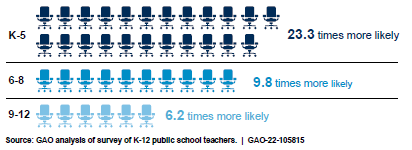Pandemic Learning: Teachers Reported Many Obstacles for High-Poverty Students and English Learners As Well As Some Mitigating Strategies
Fast Facts
The COVID-19 pandemic continued to disrupt learning for millions of students during the 2020-21 school year. However, our nationwide survey of public K-12 teachers showed that certain student populations were more likely to face significant obstacles to learning in a virtual environment.
For example:
- Teachers with mostly high-poverty students were more likely to report that their students lacked an appropriate workspace.
- Teachers with at least 20% of their students learning English were more likely to report that their students also lacked an appropriate workspace and had difficulty understanding lessons.

Highlights
What GAO Found
While the pandemic presented obstacles for many students during the 2020-21 school year, GAO's nationwide survey of public K-12 teachers showed that teachers with certain vulnerable student populations were more likely to have students who faced significant obstacles to learning and an increased risk of falling behind academically. GAO estimates that teachers who taught in a virtual environment for the majority of the year with mostly high-poverty students were about six to 23 times more likely to have students who lacked an appropriate workspace, compared to all other teachers in their grade-level band. Regarding strategies to address learning loss, GAO found, with one exception, no differences between teachers of high- and low-poverty students.
Estimated Likelihood That Teachers with High-Poverty Students Had More Students Who Regularly Lacked an Appropriate Workspace
Teachers in a Virtual Environment with High-Poverty Students Compared to All Other Teachers in Their Grade-level Band, 2020-21 School Year

Note: All estimates in this figure were statistically significant. To estimate these odds, we compared the responses of teachers who taught in a virtual or hybrid environment for the majority of the 2020-21 school year and who said that at least 81 percent of their students received free or reduced-price lunch, to all other teachers in their grade-level band (both in person and virtual). Some survey questions asked teachers to reflect on their experiences teaching in the instructional model in which they spent the majority of the year. The 27 percent of teachers who indicated they used a mix of instructional models for the majority of the year were randomly assigned to reflect on either their virtual or in-person experiences. GAO estimates that nearly two-thirds of K-5 teachers in a virtual environment with high-poverty students had at least half of their students lacking an appropriate workspace compared to 24 percent of all other K-5 teachers. We are comparing the proportion of teachers reporting that lacking an appropriate workspace was an obstacle for at least half of their students.
GAO also estimates that teachers in a virtual environment with a high percentage of English learners (at least 20 percent) were more likely than their peers to have students who regularly faced a variety of significant obstacles. These teachers were more likely to have students who regularly struggled with understanding lessons, completing assignments, having an appropriate workspace, accessing school meals, and getting adult assistance. Regarding strategies to address learning loss, teachers with a high percentage of English learners reported (1) small group work in person and (2) one-on-one check-ins between teachers and students mitigated learning loss for at least half of their students.
Several strategies helped the youngest students make some academic progress despite obstacles presented by the pandemic learning environment. Specifically, K-2 teachers reported that their students had difficulty getting support, lacked appropriate workspaces, and lacked tools for learning virtually. K-2 teachers found that movement breaks, small group work in person, and tutoring during the school day helped at least half of their students.
Why GAO Did This Study
The COVID-19 pandemic disrupted learning for millions of students, educators, and families who had to navigate in person and virtual schooling. Students in kindergarten through second grade could be at increased risk of compounded negative effects of disrupted learning over time. In addition, GAO's prior work has raised concerns about educational disparities for students from high-poverty schools and for English learners. The 2020-21 school year offered useful insights that may help schools, educators, and parents in the future.
The CARES Act includes a provision for GAO to report on its ongoing COVID-19 monitoring and oversight efforts. This second report in a series of three examines obstacles to learning and strategies to mitigate learning loss for high-poverty students, English learners, and students in grades K-2.
To address these objectives, GAO contracted with Gallup to (1) conduct a nationally representative survey of elementary and secondary public school teachers, and (2) arrange virtual discussion groups with teachers, principals, and parents of K-12 students. The overall response rate was 8.2 percent (using the American Association for Public Opinion Research's response rate 3, which accounts for the estimated eligibility rate of non-respondents). GAO analyzed the resulting survey data and discussion group responses. GAO estimated margins of error and statistical significance at the 95 percent confidence level, unless otherwise noted. To view the first report, see https://www.gao.gov/products/GAO-22-104487. To view more technical details on GAO's methods, see https://www.gao.gov/products/GAO-22-105817.
For more information, contact Jacqueline M. Nowicki at (617) 788-0580 or nowickij@gao.gov.
